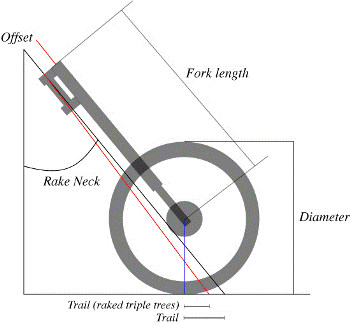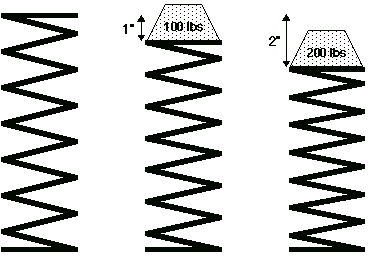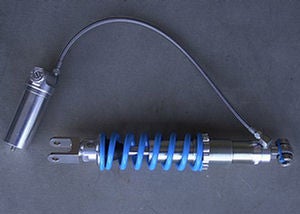 |
| Here’s a drawing of rake and trail. |
Handling - a very general word that covers a lot. So, for our needs, let's define it, just so we can get on some common ground. For our purposes, handling means: How a bike turns in the corners. Does the front end wash out, or push to the outside? Or does it tuck under and let the bike flop over in slow turns? At the rear end, handling is how the bike tracks under acceleration and how the rear end behaves over bumps. Lastly, we'll define handling as just how the bike feels “overall." In other words, does the bike move around quickly, or is it very stable and slow reacting to rider input?
While there may be minor points not covered here, this definition of handling should serve our needs adequately. You see, the reason we needed to go into all of that "defining" is because we're going to explore some thoughts on how to change the handling characteristics of your bike to suit your riding style. Now, this doesn't mean that you'll have to get out the torches and the hacksaw. Nope. The changes we'll describe here are within the scope of that mythical "average" rider, wherever he may be.
The Rear End
To understand just how little changes on a bike will alter handling characteristics, let's take a "normal" bike and, by making small adjustments, ruin the good handling traits.
Assume that we have a Yamaha YZ250 in front of us. This particular bike has no serious flaws in handling if all the suspension components are in reasonable shape and springs are not sacked out.
Okay, now let's take this Yamaha through a more or less average motocross corner. For this demonstration, make it a hard-packed, flat, second gear, right hander. After you've taken a few passes through this turn, you find out that the YZ works all right and the front end sticks reasonably well, as long as you scoot your body weight up on the tank a bit.
 |
| And here’s how this relates to a real world YZ250. |
Back to the pits. Take the side panels off the bike and fiddle with the adjusters that determine the preload on the shock spring. Take them to the softest possible position. Slip your side panels back on, and then head out to the track and that same turn once again. Chances are very good that your front end will wash out badly, no matter how far you slide up on the tank. And, if you happen to make it through that turn without falling down, you'll probably notice one other strange thing: The rear end of the bike will not be hooking up under acceleration, but it will be slithering from side to side like you have a flat tire.
Two things should be obvious at this point: one, whatever you do to the rear end will affect the front end; and two, whatever you do to the rear end will, quite naturally, affect the rear end. Item two a chimp could figure out, but item one seems to escape many riders.
The one clear, inescapable fact that emerges from this experiment is the following: If you do not have enough pre-load on your rear end, your front end will steer like a pig! This is one of the reasons you hear so many riders snivel, "Hey, my bike worked just great when it was new, but now it handles like a pile." Perhaps this complaining rider should consider compensating for sagging springs and such to restore the good manners that were built into his bike.
Invariably, when we get a chance to ride the bike of a working pro rider, we find out that the rear end is set very firm and the forks are set soft. Of course, there are exceptions to this rule because of rider personal preferences, but, by and large, this seems to be a very consistent thing.
And, we usually find out that their bikes turn very sharply on those flat, bermless corners. We could pull that same experiment on the pro's bike, reduce his preload at the rear, and his bike would lose that steering accuracy instantly.
One thing that we almost forgot to mention was the tendency of the rear end to slew around when too little preload is used. Interesting thing, that. Consider this: When you punch the throttle to accelerate, the rear end of the bike will squat down and the front end of the bike will try to rise. If your springs are way too soft (or the preload is not sufficient), the bike will wallow under the load from the engine. If the bike is not perfectly straight up and down when you accelerate, the rear end can swing wildly off to one side or the other.
PAGE 2
 |
|
This is where you change the preload on a single shock. |
This should impart another fact to you: If your bike is doing this slithering act out of most corners, you need either more preload or may need a heavier spring on your shock.
The Front End
Let’s head back to our flat corner again. This time, let's take the bike through the turn with way too much air in the forks. Normal pressure calls for little or none, but since we want to experiment, we'll slip in 10 psi just to see what will happen. O.K., end of the straightway, get on the brakes and try to turn. Whoa! Chances are you'll have a very hard time getting the bike to lean over and complete the turn. The YZ will want to "stand up.”
And, we usually find out that their bikes turn very sharply on those flat, bermless corners. We could pull that same experiment on the pro's bike, reduce his preload at the rear shocks, and his bike would lose that steering accuracy instantly.
Normally, here are some rules to follow. If you have a lot of trail, the bike will track well at high speeds in a straight line but will steer slowly and tend to push in the turns. If you have very little trail, chances are the bike will turn quickly but will not have much stability at higher speeds. This is why the forks on trials bikes are almost straight up and down and why those on drag racers are pushed out like choppers. More general rules: If you have a fairly modest rake, say 28 degrees, chances are your bike will turn well, especially at slower speeds. If you have a bike with 30 degrees, for example, it'll probably track straight and true at higher speeds and be difficult to twist through any corner without the front end washing out.
Right about this time, maybe an idea entered your head: What if you could figure out a way to get a minimal rake (28 degrees or so) combined with lots of trail? Wouldn't that give you the benefits of both, with no shortcoming to speak of?
 |
|
The rate of a spring is determined by how much resistance it gives in each inch of travel. |
Sure. That's why just about every dirt bike now made has a forward axle setup. And that's why the Maicos of the early and mid-70s had such an advantage over every other bike in the comers. They were the first with a forward axle, among other things.
How to Make Your Bike Suit Your Style
First off, we can all agree that various bikes handle differently; some are sharp turners, while others track well at high speed but are sluggish in the corners. You will not be able to make one bike do all things at all times under all conditions. If you're a desert racer, then you should set the bike up to track straight at higher speeds and sacrifice some steering accuracy in the turns.
If you're a motocrosser, you'll want that bike to turn well yet have some good stability at medium speeds for jumps and whoopers. Enduro riders, in general, will want a plusher ride but still need a bike that snakes around trees, rocks and such. Of course, the conditions in your particular area will determine just how you'll want to set your bike up. Some western enduros are little more than desert races. Some MX tracks are so tight and twisty that riders barely get over 45 mph.
(1) Always start with the rear end when making handling changes. Try to accomplish what you want with the back before you tamper with the forks. If you want to make your bike turn sharper, our first suggestion is jacking up the preload, as we discussed earlier. Naturally, you'll make sure that your springs and shocks are in good working condition before you try anything. Trying to adjust a burnt-out shock is like blowing your nose in your riding gloves. It can be done, but why bother?
The position of your rear axle can affect the front end. If you have your rear axle adjusted all the way to the back, it'll give you slightly more travel, slow the action of the rear end down and put an increased load on the shock. Generally speaking, if you move the axle all the way to the rear, your bike will get more stability at higher speeds and the rear end will respond slower. If your bike has a nasty habit of the rear end jumping out or kicking to the side over choppy bumps under acceleration, this is one of the first things you ought to try. It's like getting a lengthened swing arm free.
PAGE 3
Most bikes have about a two-inch range of adjustability in the axle slots and some have even more. The only inconvenience with this method of adjusting is that you'll have to remove links to take it forward. One note on moving that axle forward: If you ride on a tight and twisty track with a few bad bumps, the bike will turn sharper and respond quicker with the axle in the far forward position.
 |
|
To get to most shocks, the side panel must be removed. |
Moving the axle to the far rear position is also an easy way to soften your rear end up, if you happen to have a bike that comes with springs that are too stiff for your body weight and riding style.
You don't want to get into conditions of extreme preload. If you can't get the front end to start biting and all of the available preload is used up, then consider going to heavier shock springs. When this is done, you can then back off the preload and start adjusting all over again. Most fast riders prefer to be slightly over-sprung on the rear and run a light to moderate preload. You should be able to bottom your rear suspension out occasionally, but only on the most severe bumps, when you're genuinely charging. Your rear suspension should be able to take a surprise hard hit without bottoming out.
(2) Damping adjustments can add confusion to changes made at the rear. To set things straight, consider damping, what it is, and what it does. Damping (not dampening) is merely a method of slowing the action of the shock down. On compression damping, oil is forced through orifices inside the shock as the shock is being compressed. For most riders, you'll want as little compression damping as possible.
 |
| This is a Works Performance shock ready to install. |
Rebound damping is nothing more than the oil being forced through holes as the shock extends after being squashed flat. This is critical. If you have too little rebound damping, the shock can return to the fully extended position too quickly, causing the rear end of the bike to "pogo" wildly. When a shock fades, this is what happens. Insufficient rebound damping can destroy your steering in the turns and make the bike handle like a maniac over the bumps.
In general, we like to see very little compression damping and just enough rebound damping to slow the rear wheel down on the return stroke. Too much rebound damping can cause the rear end to "pack down." If your rear packs down, two things happen: Less travel is available, because the shock can hit a bump while still partially compressed; and a packed-down shock means that the geometry of the bike is now grossly off and the bike will not turn.
Forks and Fiddling
We know that changing rake and trail affect how a bike handles. The simplest way to reduce both rake and trail is to raise the forks up a bit in the triple clamps. A word of caution: If the forks dive too easily and quickly, the
 |
| Dual shocks get the same kind of preload treatment. |
front end can tuck under while you're turning. You'll have to experiment to suit your needs and riding style.
Other options are available to you for handling changes. Some of them are expensive and we'll merely
mention them to arm you with knowledge. Different length forks are available, as are trick swing arms. Both can make big changes to your geometry. Both cost lots of money.
Tires are not all the same height. Let's say that you want to add a half-inch in height to your rear end, but do not want to invest in a slightly longer shock. Measure your rear tire, then go to your local bike shop and find a taller rear knobby. Zongo – instant geometry change!
Special triple clamps are available for various bikes. These change rake and trail by changing the relationship of the steering stem to that of the forks. Peg location and height can also affect handling by allowing the rider a more pronounced weight shift than the stock setup. A simple thing like bar shape can also make the bike easier to turn. Experiment to suit you needs.
One Last Factory
All of the adjustments and changes aside, one last important thing can also greatly affect how your bike handles … that's the rider, and where he is on the bike. Learn how to get your weight forward for the turns and back on for straights. Move around on the bike. After all, the most adjustable thing on that entire motorcycle is you.


 Your Privacy Choices
Your Privacy Choices